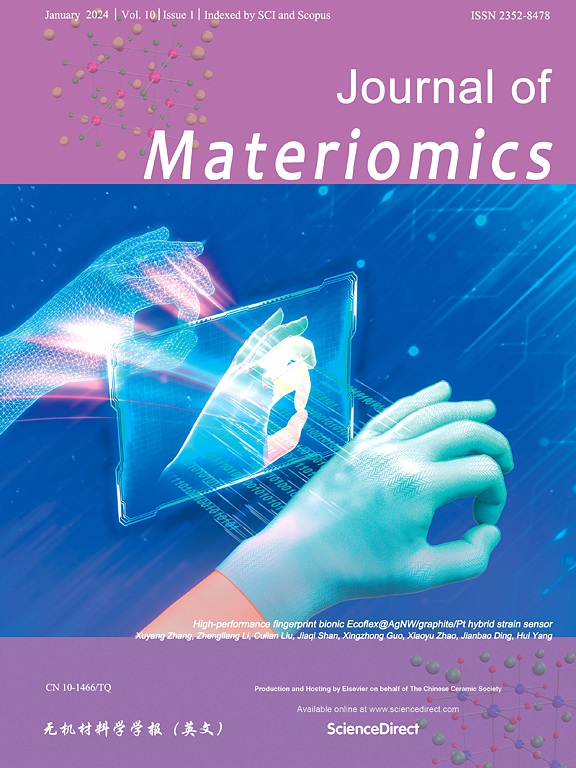共价共掺杂在bnt基陶瓷中诱导弛豫态并增强电应变
IF 9.6
1区 材料科学
Q1 CHEMISTRY, PHYSICAL
引用次数: 0
摘要
开发高性能无铅电应变材料是推进下一代机电技术的关键。本文报道了一种基于(Bi0.5 na0.5) tio3 (BNT-based)陶瓷的共价共掺杂策略,其中a位(Li+)和b位(Nb5+)同时共掺杂得到(1−x)Bi0.5(Na0.81K0.19)0.5TiO3-xLiNbO3 (BNKT-xLN, x = 0.01-0.04)组合物。共价取代破坏了长程铁电序,增强了晶格畸变,促进了具有扩散相变和强介电色散的类弛豫态。互补极化电场(P-E)和应变电场(S-E)测量表明,随着掺杂水平的增加,从经典铁电行为逐渐演变为非过能弛豫行为。在x = 0.02时,优化的组合物表现出约0.55%的可逆电应变,并伴有温度驱动的可逆相变。值得注意的是,BNKT-xLN陶瓷实现了超过50 μC/cm2的电场诱导极化,同时表现出相对较低的电伸缩系数Q33 (~ 0.018 m4/C2),表明由于弱极化-应变耦合效应,它们具有作为储能矩阵的潜力。这些结果强调了共价共掺杂策略在调节基于btc的系统的能量格局中的重要性,为开发适合下一代执行器和储能设备的高应变无铅电陶瓷提供了可行的策略。本文章由计算机程序翻译,如有差异,请以英文原文为准。

Aliovalent co-doping induces relaxor states with enhanced electrostrain in BNT-based ceramics
Developing high-performance lead-free electrostrain materials is key to advancing next-generation electromechanical technologies. Here we report an aliovalent co-doping strategy in (Bi0.5Na0.5)TiO3-based (BNT-based) ceramics, where simultaneous A-site (Li+) and B-site (Nb5+) co-doping yields (1−x)Bi0.5(Na0.81K0.19)0.5TiO3-xLiNbO3 (BNKT-xLN, x = 0.01–0.04) compositions. The aliovalent substitution disrupts long-range ferroelectric order, enhances lattice distortion, and promotes a relaxor-like state with diffuse phase transitions and strong dielectric dispersion. Complementary polarization–electric field (P–E) and strain–electric field (S–E) measurements demonstrate a progressive evolution from classical ferroelectrisc to nonergodic relaxor behavior as the doping level increases. The optimized composition at x = 0.02 exhibits a large reversible electrostrain of approximately 0.55% associated with a temperature-driven reversible phase transition. Notably, BNKT-xLN ceramics achieve electric-field-induced polarizations exceeding 50 μC/cm2, while exhibiting a relatively low electrostrictive coefficient Q33 of ∼0.018 m4/C2, suggesting their potential as energy storage matrices due to the weak polarization–strain coupling effect. These results underscore the importance of aliovalent co-doping strategy in modulating the energy landscape of BNT-based systems, offering a viable strategy for developing high-strain, lead-free electroceramics suited to next-generation actuators and energy storage devices.
求助全文
通过发布文献求助,成功后即可免费获取论文全文。
去求助
来源期刊

Journal of Materiomics
Materials Science-Metals and Alloys
CiteScore
14.30
自引率
6.40%
发文量
331
审稿时长
37 days
期刊介绍:
The Journal of Materiomics is a peer-reviewed open-access journal that aims to serve as a forum for the continuous dissemination of research within the field of materials science. It particularly emphasizes systematic studies on the relationships between composition, processing, structure, property, and performance of advanced materials. The journal is supported by the Chinese Ceramic Society and is indexed in SCIE and Scopus. It is commonly referred to as J Materiomics.
 求助内容:
求助内容: 应助结果提醒方式:
应助结果提醒方式:


